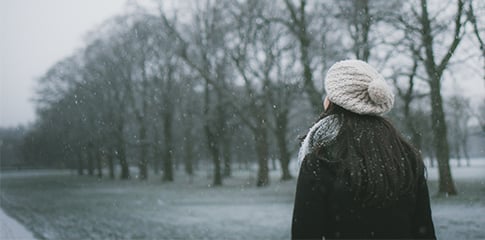When is cold and flu season?
In Europe, winter is our flu season. It’s mostly caused by the influenza virus, which begins around October and peaks between December and February.
There are three types of flu: imaginatively named influenza A, influenza B and influenza C. A and B are the most common, while C is the most harmless and not thought to be responsible for any pandemics. In other words, if you’re going to get the flu, the best one to catch is influenza C.
Is there a common cold season?
There is to a certain extent, but the common cold is not caused by cold weather despite its name. Cold and flu are both viral infections, just from different viruses. But they both love the cold and even the name ‘influenza’ shows the link. Taken from the original Italian name influenza di freddo, it means “influence of cold”.
Here’s a surprising fact… The rhinovirus is the most common cause of the common cold. It can prevent you from getting the flu by jumpstarting your antiviral defences. In short, if you want to avoid the flu then catch the common cold! And don’t worry, it’s extremely rare to get cold and flu at the same time.
Why is winter the time for seasonal cold and flu?
There are some theories why the flu strikes in winter. People spend more time indoors with the windows closed. You’re then more likely to breathe the same air as someone who has the flu. The shorter days mean less sunlight and less vitamin D. This gives your immune system a bashing, meaning it finds it harder to fight the virus. Flu is preventable with a vaccine, whereas the common cold isn’t.
Is seasonal flu really that serious?
Some of us really don’t take colds and flu that seriously, but it’s a mistake. It affects 5-15% of the population in the northern hemisphere. No small number. And in Europe, about 10% of all sickness-related absences from work are related to flu.
Scientists don’t know as much as they would like about human flus and colds because they don’t work the same way on animals. In other words, the only way to research them is to perform scientific experiments on humans. Not really an option, eh?
But what is clear is there’s been an extreme drop in cold and flu cases since COVID-19. Wearing masks and social distancing rules have not only protected us from coronavirus, but also the cold and flu viruses. As always, prevention is better than cure.
The five best ways to beat a cold or flu
Although the common cold and flu are different, you can help relieve your symptoms in the same way.
- Keep hydrated and drink lots of liquids: cold or warm water, water with lemon and/or honey, fruit juices and thin, clear soups. But some drinks will have the opposite effect. Ditch the coffee and alcohol, as this’ll dehydrate your body and leave you feeling worse.
- Rest up! A simple but effective way to regain your strength, and it means you can catch up on your boxsets too.
- Sore throat making you want to sob? Soothe it quickly by gargling with warm water and half a teaspoon of salt.
- Want to tell your snotty nose to get stuffed? Grab some saline nasal drops from your pharmacist.
- Need a superhero to soothe that sore nose? Our Kleenex® Balsam Tissues have a protective balm of aloe vera, vitamin E and calendula.












